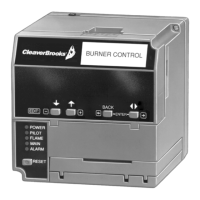What to do if the Keyboard Display Module is scrambled in CleaverBrooks CB780?
- IIsabel PatrickAug 6, 2025
Remove and reinstall the Keyboard Display Module, and reset the CB780/CB784 Relay Module.

What to do if the Keyboard Display Module is scrambled in CleaverBrooks CB780?
Remove and reinstall the Keyboard Display Module, and reset the CB780/CB784 Relay Module.
What happens if voltage is detected at the terminal of CleaverBrooks CB780 Relays?
If voltage is detected at the terminal, 'ON' is displayed.
Why maximum ambient operating temperature of an 8171121 flame sensor, Series 1 through 6 is reduced to 125°F in CleaverBrooks CB780 Relays?
The maximum ambient operating temperature of an 8171121 flame sensor, Series 1 through 6 will be reduced to 125°F due to the duty cycle operation of the CB780/CB784 Relay Module.
| Brand | CleaverBrooks |
|---|---|
| Model | CB780 |
| Category | Relays |
| Language | English |
Details the conditions under which safety shutdowns (lockouts) occur.
Explains how the CB780/CB784 checks its internal hardware integrity.
Describes the test verifying the integrity of safety critical loads.
Details wiring connections, compliance with codes, and recommended wire size and type.
Guidance on vertically or horizontally mounting the CB780/CB784 unit.
Steps for removing the old purge card and inserting a new one.
Details the step-by-step burner sequence the CB780/CB784 follows.
Explains the initial sequence state upon power application or voltage fluctuations.
Describes the state where the control is ready to start an operating sequence.
Details the PREPURGE timing and conditions for starting the sequence.
Explains jumper options for configuring PFEP and Interlock Check.
Outlines general steps and precautions for performing checkout tests.
Checks wiring, detector cleanliness, amplifier/detector combination, and secure component seating.
Explains how self-diagnostics and first-out annunciation aid in troubleshooting.
Recommendations for securing the device from unauthorized access and tampering.
Guidance on protecting device functionality and interface protocols.
